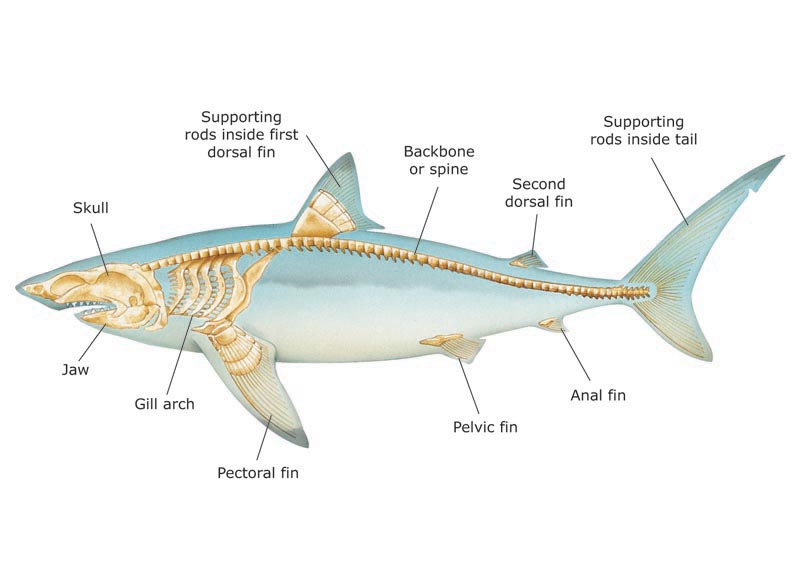Analogous traits, or evolutionary responses due to environmental changes and stress can be seen throughout the animal kingdom. Once such example are sharks and dolphins, and while neither share a common ancestor both posses dorsal and pectoral fins with a similar body shape. Sharks being fish and dolphins mammals is clear sign of an analogous trait they both share. The streamlined body is essential in helping them to move quickly and muscles designed to propel them at amazing speeds.
However when we take a closer look at both these species the differences become clear. Such as both the difference in skeletal structure and its composition, cartilage for sharks and bones for dolphins.
We can see they both share the elongated spine which allows for the body to take its torpedo like appearance. Not surprisingly however, despite the appearance of a dolphins flipper it has the same skeletal structure as many other mammals; and unlike a shark it is able to move its flipper with limited range of motion. Such bones like the radius and ulna for example are present in mammals. When we look at a shark it has the appearance of a typical fish fin, complete with all those tiny little bones.
Going back to the ancestors of both species it is apparent that sharks have not really changed much since their first appearance around 450 mya, but the dolphin evolved from something different. It is also no surprise they both developed similar traits as these are the most effective means of movement in water.
Homology a trait passed through a common ancestor and seen in different species and is and is a sign that there is a genetic relationship. Like the dolphin example above whales also posses a bone structure with a likeness to our own. So humans and whales share a homologous trait. Looking at the bone structure in the hand of a human and the fin of a whale again we can see how closely related they are. Even though this image has other animal examples I would to only focus on the 2 on the far left.
Of course due to the different living environments each species had to evolve its signature characteristic. Having our current arm shape wouldn't allow a whale move very fast in the water, and us having flippers of course would halt our ability to use tools.
The above image features the common ancestor of man and whale. It wouldn't be hard to imagine this animal taking to the water and evolving into the whales we see today or even over time walking upright and becoming us. The fossils dug up of these interesting creatures have told us so many things about our origins.






"...while neither share a common ancestor both posses dorsal and pectoral fins with a similar body shape."
ReplyDeleteAll organisms share a common ancestor if you go back far enough, including these two organisms. The question is, did that common ancestor possess and pass on the trait in questions.
The answer is a partial "yes". The common ancestor was an early fish and it did pass on its body shape to the shark. However, we know that the dolphin developed it's body shape after it split off of early land mammals, long after the split from sharks. That means it developed it's body shape trait independently from that common ancestor. These are therefore analogs.
Good description on your homologous traits but you can be a little more specific on your ancestry than the reptilian ancestor. Both humans and whales are mammals. They inherited their limb structure from a common mammalian ancestor who possessed the ancestral limb structure. That means these traits have a genetic relationship and are homologs.